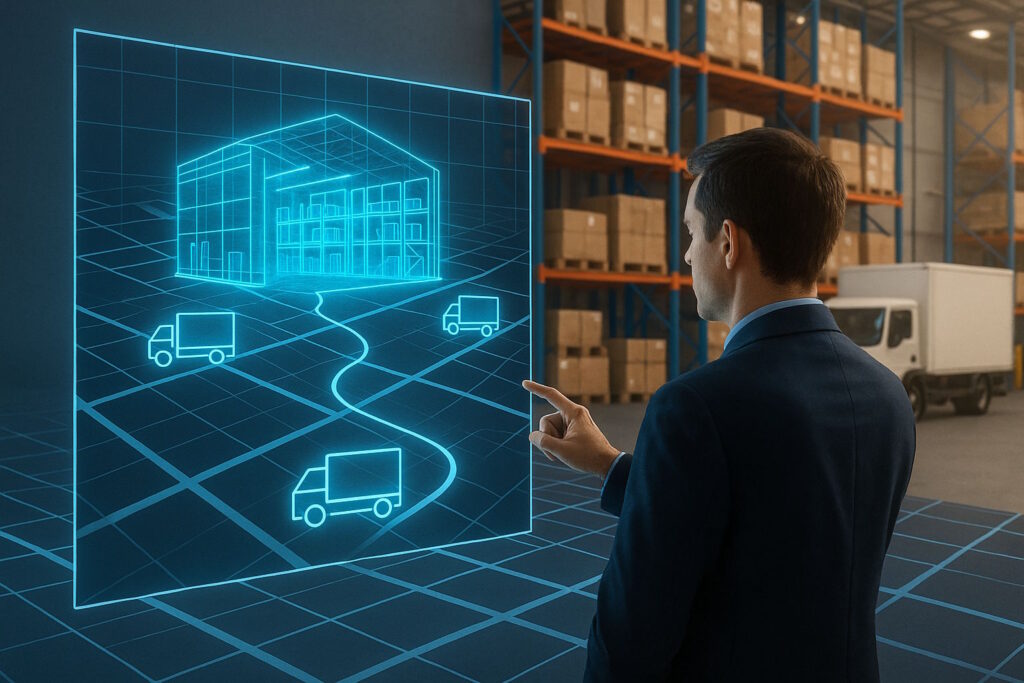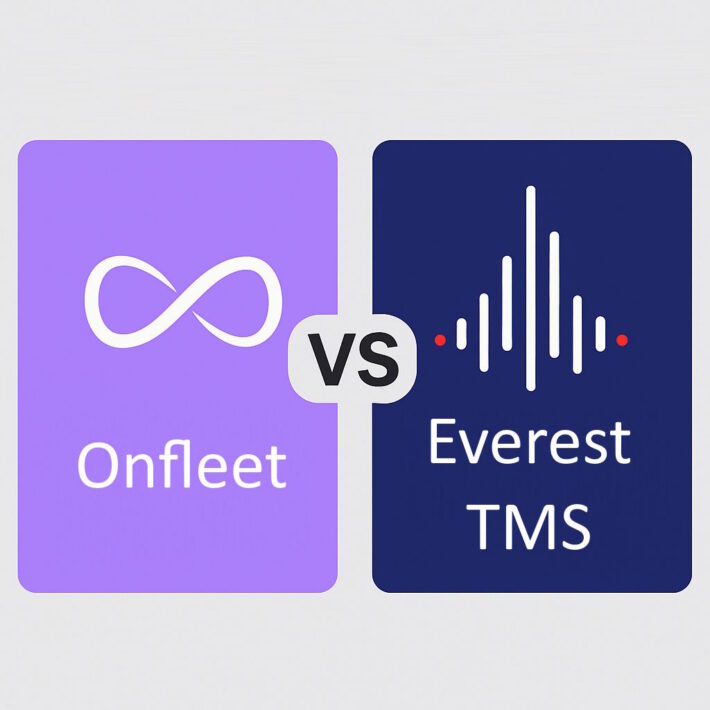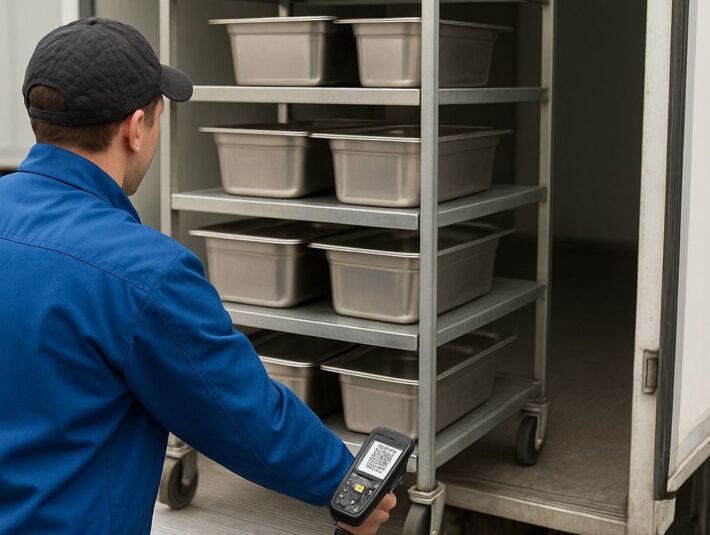Digital Twin Logistics: Simulate Before Optimizing

What if you could test your new delivery routes without mobilizing a single vehicle? Anticipate peak activity without taking any risk? Reorganize your warehouse without moving a single box? Welcome to the world of digital twins, the technology that transforms logistics into a virtual laboratory where every decision can be simulated, tested, and optimized before being applied in the real world.
The digital twin market is expected to reach $35.8 billion in 2025, ten times more than in 2019. This explosion is explained by a simple yet revolutionary promise: transforming uncertainty into actionable data. No more decisions made in the dark or risky investments. Welcome to virtual experimentation where every scenario can be played, replayed, and refined to perfection.
What exactly is a digital twin?
Much more than a simple simulation
Imagine a perfect virtual replica of your logistics network: your warehouses, your vehicles, your routes, your constraints. This digital copy doesn’t just exist statically. It lives, breathes, and evolves in real-time, continuously fed by data from your actual operations.
A digital twin combines three essential ingredients: a precise digital definition of your system (from your CAD, PLM, or TMS data), operational data collected via IoT sensors and telemetry, and an information model that correlates and presents this data to facilitate decision-making.
Unlike a traditional simulation that offers fixed predictions, the digital twin maintains a permanent dialogue with the physical world. When a vehicle breaks down in your actual fleet, its virtual counterpart records the incident and automatically adjusts its forecasts. This constant feedback loop makes all the difference.
The three types of digital twins in logistics
The process twin models your end-to-end logistics flows: from order reception to final delivery, including storage and preparation. It simulates each step to identify bottlenecks and test improvements.
The asset twin virtually reproduces your physical equipment: delivery vehicles, warehouse robots, automated storage systems. Each machine has its digital clone that monitors its performance and predicts maintenance needs.
The organizational twin goes even further by modeling your entire logistics chain, from inventory management to delivery routes, integrating all external variables: weather, traffic, customer demand, resource availability.
Why digital twins are revolutionizing logistics
Test without risk, optimize without limits
The main advantage of digital twins? The ability to experiment freely without real consequences. Want to know if a new route organization will be more efficient? Simulate it virtually for a full week and analyze the results before mobilizing a single vehicle.
This anticipation capacity radically transforms decision-making. Instead of relying on intuition or theoretical calculations, logistics managers can concretely visualize the impact of their choices. How many kilometers saved? What gain in delivery times? What workload for teams? The digital twin answers all these questions before you even take action.
Detect problems before they occur
Digital twins excel at anticipation. By continuously analyzing data and cross-referencing historical information with current trends, they detect weak signals indicating problems.
A spike in orders is coming? The digital twin identifies saturation risks and suggests adjustments: temporary staff reinforcement, modified delivery slots, resource reallocation. An area systematically becomes problematic in late afternoon? Virtual analysis reveals it’s better served in the morning to avoid traffic jams.
This predictive maintenance extends to equipment: abnormal vehicle vibrations, declining sorting system performance, premature component wear. The twin detects these anomalies and schedules interventions at the optimal moment, avoiding costly breakdowns and enabling maintenance cost reductions of 10 to 40%.
Real-time optimization based on context
Modern logistics requires constant adaptation to unexpected events. An accident blocks the highway? Bad weather disrupts deliveries? A customer modifies their order at the last minute? The digital twin instantly recalculates the best options.
This reactivity relies on its ability to integrate external data in real-time: traffic conditions, weather, team availability, inventory status. It doesn’t propose a theoretical optimal solution, but the best possible response in the current context.
Concrete use cases: when virtual transforms reality
STEF digitalizes its temperature-controlled transport network
The European specialist in temperature-controlled logistics restructured its entire network using digital twins. By installing IoT sensors in its trucks to monitor temperature in real-time, STEF created a complete virtual replica of its logistics flows.
The digital twin virtually models the entire network, simulates truck and warehouse activity, identifies potential anomalies, and automatically adjusts routes or loads. Result? STEF performs more operations with a reduced fleet: decreased operating costs, reduced environmental footprint with less fuel consumption and fewer CO2 emissions.
This approach also optimizes truck loading based on each product’s thermal constraints, ensuring cold chain integrity while maximizing fill rates.
Mars optimizes its food supply chain
The food giant deployed digital twins to synchronize its production with distribution. The objective: anticipate seasonal demand peaks, optimize inventory, and streamline shipments from factories to points of sale.
The digital twin simulates different production and supply scenarios based on sales forecasts. It identifies shortage risks, proposes schedule adjustments, and optimizes flows between warehouses. This global visibility enabled Mars to accelerate decision-making processes while reducing logistics costs.
Maersk and Hapag-Lloyd revolutionize maritime transport
Shipping giants use digital twins to optimize their maritime routes. By simulating various navigation scenarios integrating weather conditions, ocean currents, geopolitical tensions, and port availability, they identify the most efficient routes.
These virtual replicas allow testing the impact of unforeseen events: storm on a classic route, congestion at a major port, availability of a new passage. The twin instantly calculates alternatives and proposes the best route in terms of time, cost, and carbon footprint.
The Maritime and Port Authority of Singapore even goes so far as to develop a virtual double of its future container mega hub, simulating port operations to minimize congestion before the terminal is even built.
How to implement a logistics digital twin
Define scope and objectives
The first step is determining what you want to optimize. Is it your delivery routes? Your warehouse organization? Your complete distribution network? The more precise the scope, the more effective the digital twin will be quickly.
Set measurable objectives: reduce kilometers traveled by 15%, decrease delivery delays by 25%, optimize vehicle fill rates by 20%. These KPIs will guide twin configuration and enable concrete results evaluation.
Collect and structure data
A digital twin feeds on data. The more numerous and reliable they are, the more accurate simulations will be. Identify your sources: TMS data (delivery history, route performance), customer information (order frequency, delivery constraints), operational data (vehicle capacity, team availability).
IoT sensors considerably enrich this base: real-time vehicle geolocation, equipment status, transport conditions (temperature, vibrations), fuel consumption. This data transforms a static twin into a dynamic system that evolves minute by minute.
Deploy progressively
No need to model everything at once. Start with a limited use case: optimize routes in a specific geographical area, test a new dispatch organization, anticipate workload during a risky period.
This progressive approach allows validating digital twin effectiveness on a controlled scope before extending it to your entire activity. It also facilitates team buy-in who quickly see concrete benefits.
Integrate with your existing TMS
A digital twin doesn’t replace your TMS, it complements it. Integration between the two systems is essential to maintain data consistency and enable optimal simulation exploitation.
At Everest, our REST JSON API facilitates this interconnection. Your activity data automatically feeds the digital twin, which in return proposes recommendations directly exploitable in your TMS: new optimized routes, preventive alerts, schedule adjustments.
Measurable benefits of digital twins
Immediate operational gains
Companies deploying digital twins quickly notice tangible improvements. Route optimization generates savings of 10 to 30% on transport costs: fewer kilometers traveled, better vehicle fill rates, reduction in empty runs.
Predictive maintenance reduces unplanned downtime and extends equipment lifespan. According to a Gartner study, two-thirds of companies using connected objects will have deployed at least one digital twin in production by 2022. Interventions are scheduled at optimal times, avoiding breakdowns during peak activity and associated emergency costs.
Continuous improvement and agility
Beyond immediate gains, digital twins establish a culture of continuous improvement. Every new idea can be tested virtually before implementation, transforming innovation into a systematic process rather than a risky bet.
This experimentation capacity accelerates market evolution adaptation. New service to launch? New area to serve? Fleet expansion? The digital twin simulates all scenarios and helps you make the right strategic decisions.
Reduced environmental impact
Logistics flow optimization directly translates into reduced carbon footprint: fewer kilometers traveled means fewer CO2 emissions, better route organization allows easier integration of decarbonized vehicles, demand anticipation limits unnecessary inventory and waste.
Digital twins even become environmental reporting tools: they automatically calculate each delivery’s emissions, enable comparing different options based on their carbon impact, and generate indicators necessary for your CSR reports.
What about tomorrow? The future of digital twins in logistics
Generative AI serving simulation
Integrating generative artificial intelligence will further enrich digital twin capabilities. Instead of manually testing different scenarios, you can simply describe your objective in natural language: “How can I reduce my delivery costs by 20% while maintaining my deadlines?” AI will automatically generate relevant simulations and propose optimal solutions.
This conversational approach democratizes access to digital twins. No need for advanced technical expertise to exploit simulation power. Any logistics manager can query their digital twin and obtain actionable recommendations.
Interconnected twins and collaborative ecosystems
Tomorrow’s digital twins will be interconnected, forming virtual logistics ecosystems where carriers, retailers, and platforms collaborate in real-time. Your twin will communicate with those of your customers and partners to optimize the entire value chain.
This vision requires interoperability standards and shared data governance. European initiatives like the Living Digital Twins program prepare this ground by defining necessary common protocols and frameworks. According to an OPIIEC study, the digital twin market is experiencing impressive growth with +39.1% annual global revenue forecast through 2030.
Crisis simulation and resilience planning
Digital twins will become essential crisis management tools. By simulating major disruption impacts (natural disaster, strike, resource shortage), they’ll enable developing robust business continuity plans.
This approach transforms logistics resilience from a theoretical concern into tested and validated operational capacity. You no longer wonder “what would we do if…” but “here’s how we’ll react when…”.
Key Takeaways
Digital twins radically transform logistics management by enabling testing, optimizing, and anticipating in a virtual environment before any real implementation. This technology is no longer reserved for logistics giants: with the democratization of IoT, cloud, and AI, it’s becoming accessible to transport and distribution SMEs.
Benefits are immediate and measurable: 10 to 30% reduction in operational costs, resource optimization, decreased carbon footprint, and improved service quality. According to Gartner, 60% of companies currently use or plan to implement digital twins throughout their Supply Chain. Beyond quantifiable gains, digital twins primarily establish a new way of managing logistics operations: data-based, simulation-guided, and continuous improvement-oriented.
At Everest, we believe simulation should integrate naturally into your daily operations. Our open API facilitates connection with digital twin tools, enabling enriching your logistics decisions with virtual modeling power. Because optimizing your routes, anticipating your activity peaks, and reducing your costs should never be a gamble, but a certainty.
The future of logistics isn’t guessed, it’s simulated.



